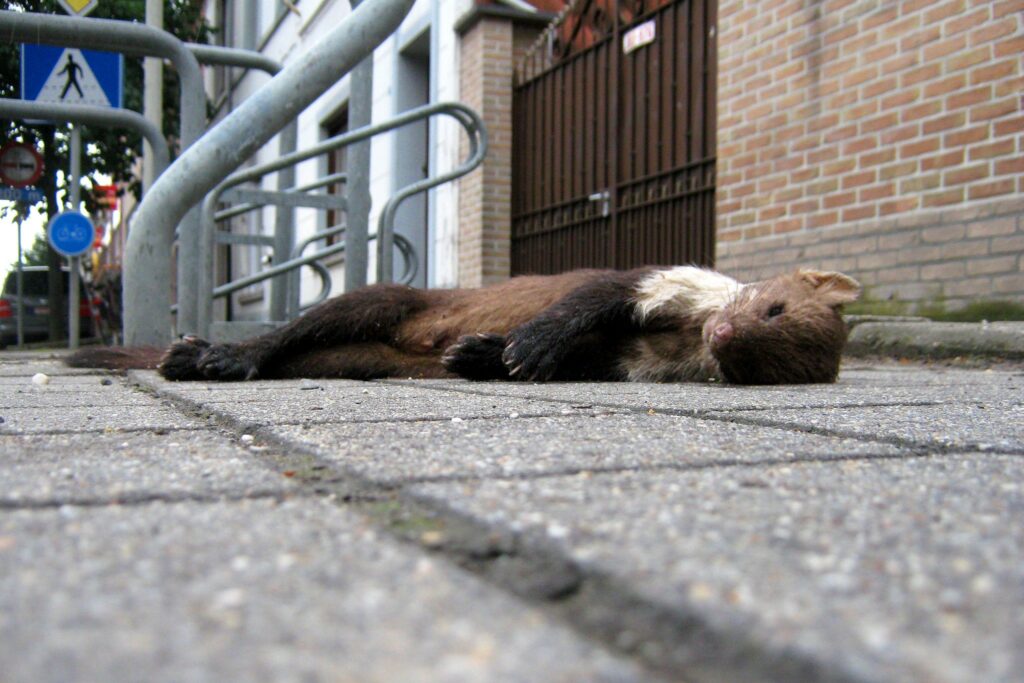Toxoplasma in a stone marten
In early 2015 an adult male stone marten was submitted to the DWHC for post-mortem exam. The animal was in good nutritional condition and there was evidence of fatal trauma to the head consistent with roadkill. In addition, there was inflammation of the heart due to infection with Toxoplasma gondii; this may have contributed to poor fitness whereby the animal was not able to avoid collision with a vehicle. The presence of this protozoan parasite was confirmed using a special tissue-staining technique known as Immunohistochemistry.
The life cycle of this parasite involves definitive (felids that have not previously been infected) and intermediate (all warm-blooded animals) hosts. Only in the definitive host are eggs (oocysts) produced and these are excreted by the million in the feces and can survive for up to 1.5 years in the environment. These oocysts are the source of infection of intermediate hosts in which motile forms of the parasite leave the oocyst and migrate through the body forming cysts in muscle and nervous tissue (tissue cysts). ¹ In turn, the ingestion of tissue cysts in prey can result in infection of cats and other animals that ingest the affected hosts.
Photo: Sponzen Ridder
The consequences of infection vary per species and range from subclinical infection to death which has been described in hares and squirrels in the Netherlands.
It has been shown that infected mice lose their flight-response, making them easy prey for predators such as cats. The effect of infection on stone martens is unknown. In a Spanish study, antibodies (indicating exposure to the parasite at some point in time) to T. gondii were found in 85% of stone martens killed on the road (n=20). The authors of do not report whether or not lesions were found in the animals testing positive. This relatively high prevalence supports the hypothesis that the percentage of carnivores with antibodies to this parasite is high due to the cumulative effect of the continued consumption of infected meat3.
Reporting dead stone martens
The DWHC will continue to monitor the health status, and in particular, the occurrence of toxoplasma in the Dutch stone marten population and you can help by reporting finding a dead animal via the submission form on our website. For microscopic examination of these animals it is essential that the cadavers are in a fresh state i.e. not dead for more than one day; cadavers should not be frozen. It is therefore preferable to report dead stone martens as soon as possible and to keep the cadaver in a cool (not frozen) place until it can be collected. After submitting your form you will be contacted by the DWHC who will help decide whether the animal is suitable for submission and advise you on how to package the cadaver and arrange collection of the packaged stone marten from your home or place of work.
For more information about toxoplasmosis in people visit the website of the OIE
References
- Opsteegh, M. 2012. Toxoplasmose: risico’s voor de jager. De Nederlandse Jager, 23 (2012) : 6
- Kannan, G., K. Moldovan, J.C. Xiao, R. H. Yolken, L. Jones-Brando and M. V. Pletnikov. Toxoplasma gondiistrain-dependent effects on mouse behaviour. Folia Parasitologica 57[2] (2010) : 151–155,
- Sobrino, R. , O. Cabezón , J. Millán, M. Pabón , M.C. Arnal, D.F. Luco, C. Gortázar , J.P. Dubey, S. Almeria , Seroprevalence of Toxoplasma gondii antibodies in wild carnivores from Spain. Veterinary Parasitology 148 (2007): 187–192



